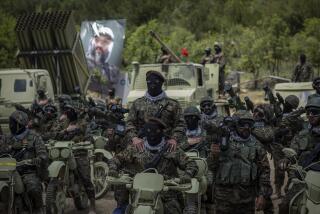Military seeks cover from oil crunch
Across the oil-thirsty U.S. military, commanders are scrambling for ways to offset the ever-rising cost of fuel. But their best efforts so far have fallen short.
The military services have found ways to save millions of dollars through conservation, but the price of oil has outpaced the cost-cutting efforts. The Navy, for example, estimates that it is saving $300 million a year through conservation. That sounds impressive until the oil price jump is taken into consideration.
“From July through Sept. 30, we will see a $400-million increase in our fuel bill,” said Navy Capt. Arthur Cotton, head of the Fleet Training and Readiness reporting branch. “So all of those energy savings we have done are wiped out, and then some, just over the period of 90 days.”
Overall, the Pentagon will spend $16.4 billion on fuel this year, up from $5.2 billion in 2003.
The increase has made the wars in Iraq and Afghanistan more expensive, adding $140 million to the cost of operations in Afghanistan and $565 million in Iraq. The wars combined are costing $12.1 billion a month. Military officials emphasize that the increases have not affected how combat operations are being conducted.
The Defense Department’s biggest fuel users are the Air Force, which accounts for 52% of the fuel bill, and the Navy, which uses 32%. Within those branches, conservation efforts are wide-ranging.
A decades-old initiative to scrub the hulls of Navy ships, reducing drag and making them faster and more efficient, is gaining new importance.
The Navy also is stepping up efforts to replace live exercises with virtual maneuvers that allow sailors to train while keeping the ships in port. This year the Navy will conduct 124 “synthetic exercises,” up from 84 last year. A study last year showed that the initiative saved $160 million.
The Air Force and the Navy also are considering increases in flight simulator training, although a large-scale shift is likely to wait until after a Defense Department study is completed by late next year.
For its part, the Air Force is attempting to reduce planes’ taxiing and idling time. It is working to reduce aircraft weight, lower the amount of excess fuel some planes carry, and make flight paths more efficient. And on Air Force bases, the service is beginning to replace pickup trucks with souped-up golf carts.
William C. Anderson, an assistant Air Force secretary who oversees energy issues, said commanders were trying to encourage a culture change, giving fuel efficiency higher priority.
“We are getting our teams to think about saving energy while still doing the mission,” he said.
The skyrocketing fuel cost has been particularly difficult for the Air Force. In recent years the Air Force, the largest user of fuel in the federal government, had intended to pay for new planes by reducing the number of airmen. But the increase in fuel prices ate up those savings.
Soon, other services may face the same squeeze and suffer the cancellation or delay of significant equipment programs as a result of fuel price increases.
Each military branch must present a draft of its next budget to the secretary of Defense by early August. And the comptroller’s office has warned the services that they must accommodate fuel price increases in their budgets. Top military officials are mum on what spending programs might be in line for cutbacks.
For now, the officials are predicting that fuel prices will decline 4.8% next year. But the Pentagon has not been especially accurate with its projections. The Defense Department originally estimated that oil this year would cost $91 a barrel; military services are currently paying nearly $171 a barrel. Much of the price hike this year was covered by Congress in the recently enacted emergency war funding measure. Because of its heavy use of jet fuel, the Air Force has taken perhaps the most aggressive steps toward conservation and alternatives to petroleum fuel.
Air Force officials hope that liquid coal becomes a viable alternative to petroleum, and they are working to ensure that all their aircraft can use synthetic fuels. Over the long term, the Air Force is trying to develop more efficient engines and airframe designs.
“We are trying to look all the way down the road,” Anderson said. “We are trying to run the gamut in terms of looking for alternatives and new ideas.”
For the military, this represents a marked change from years past, when fuel efficiency was scarcely considered in the development of new weapons systems.
“We fully expect that in the future it will become a bigger part of that decision process,” Anderson said.
--
More to Read
Sign up for Essential California
The most important California stories and recommendations in your inbox every morning.
You may occasionally receive promotional content from the Los Angeles Times.










